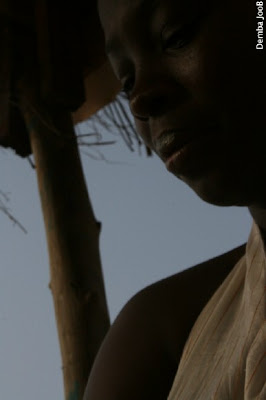
 Survie
Survie
 man..well let me tell you I browsed through the entire book I couldn't stop turning the pages to see his work and mostly read his story
man..well let me tell you I browsed through the entire book I couldn't stop turning the pages to see his work and mostly read his storyArtist Soly Cissé likes to laugh. And he has every reason to do so. At age 39 he is among his country Senegal’s internationally best-known artists. He represents his country at major exhibitions and biennials all over the world, for example in São Paulo, Havana, and of course Dakar, the city where he was born in 1969, and where he still lives today. He has had solo exhibitions at the Luiggi Pecci Museum in Prato, Italy; at the Rautenstrauch-Joest Museum in Cologne; at the Maerzgalerie in Leipzig; at the Galerie La Trace in Paris; and at the Galerie Dany Keller in Munich, where he showed paintings, drawings, and pastels in a show titled Existences.
If one takes a closer look at this exhibition, one would have trouble believing that Cissé is a cheerful and happy person. What he shows us in these images is no longer an ideal world, but a lost, doomed one. The increase in catastrophes gives humanity a bitter foretaste of the end. Cissé is especially solicitous of animals, because he has had a very close relationship to them since his childhood, but in accordance with the traditional rules of his religion he can no longer touch them as an adult if he doesn’t want to be rendered impure. To remain close to them, he paints them, not as specific individuals, but rather as they come to his mind. For this reason, in his paintings, they often resemble fabulous creatures more than the living animals we know in reality. He paints them with their muzzles opened wide in fear and their teeth bared, so that one almost hears their wailing, for example, in the large painting Victims of Inundation, where masses of water sweep everything away, a symbolic rendering of a flood with terrible consequences for people and animals in Dakar three years ago. This incident showed him once again that the world is moving in a direction from which it can no longer be steered away. He wants to draw our attention to this in his work. Despite all his cheerfulness, Cissé has a very serious message.
Cissé is not interested solely in environmental disasters. He is also concerned about the loss of what makes his own little world lovable and worth living in. This includes tradition, which gives people’s lives a rhythm and order. It sets limits, which results in respectful dealings with each other. Especially in a city of millions, like Dakar, they are exposed to so many influences that they can hardly find anything to hold onto. His drawing Lost World shows young people’s lack of chances. These young people seem naked, exposed, disoriented, and distorted. They live on the street like animals and have no stability.
Again and again, Cissé writes across his paintings rows of numbers reminiscent of commercial barcodes. Everything is counted, weighed, and categorized; only the human being no longer knows his place in the world. Like the Dancer in the Mountains, he is alone and thrown back upon himself. But there he finds an audience, at least in animals. Yet something uncanny is brewing in nature. Accordingly, Cissé’s work has something roughened, agitated, even threatening about it. Sometimes he covers the canvas with thin paper to produce structures on the surface that seem like scars, and recall the network of cracks in the varnish on the paintings of the Old Masters. Despite the weight of content that Cissé’s paintings bear due to their troubling themes, they are never moralizing. That eases some of their disturbing quality. The viewer can breathe an intermittent sigh of relief, because what seems so terrible in an image turns out to be completely harmless. For example, in After the Train, where the tracks lead into a void, to the right and left of them, animals tumble in confusion. Is this an apocalyptic scenario? No, he laughs, and points to the dead fish under the crossties. Far and wide, no water, so where does the fish come from? From a market stand, because on market day the women in Senegal like to set up their stands in the track bed. When a train approaches with deafening noise, everyone flees with their possessions, and sometimes a dead fish can be left behind.
Cissé definitely has a sense of the comedy of everyday life. He sketches a lot, observes people and animals, how they present themselves, and the faces and grimaces they make. He thereby seeks the vocabulary, so to speak, with which he can create images. His work is never a direct reproduction of what he sees or experiences; it is always a transformation. For Cissé, reality is always simultaneously an occasion and an excuse for creating art.

















 Alain Mabanckou, CONGO,Noted Writer, Professor
Alain Mabanckou, CONGO,Noted Writer, Professor Thomas Tapeh, LIBERIA, NFL Playa
Thomas Tapeh, LIBERIA, NFL Playa Amr Waked EGPYT, Actor
Amr Waked EGPYT, Actor
 Borris Kodjoe, GHANA, Actor, Producer, Husband and Father
Borris Kodjoe, GHANA, Actor, Producer, Husband and Father
 Madalitso Muthiya,ZAMBIA, Golf Playa
Madalitso Muthiya,ZAMBIA, Golf Playa Knaan , SOMALIA, Singer and Social Activist
Knaan , SOMALIA, Singer and Social Activist
 Idris Elba, SIERRA LEONE, Actor Dj Father
Idris Elba, SIERRA LEONE, Actor Dj Father Oumar Mukhtar, LYBIA, Resistant to Italian conquest of his coutry, National Hero
Oumar Mukhtar, LYBIA, Resistant to Italian conquest of his coutry, National Hero


 Roshdy Zem, MAROC, Actor, Husband and Father
Roshdy Zem, MAROC, Actor, Husband and Father




 Gad Elmaleh, MAROC,Comedian and Movie Director
Gad Elmaleh, MAROC,Comedian and Movie Director























